The coal boiler for hot water in the home
The 'boiler' was an appliance for heating water for domestic use. Like the earlier copper, it was coal-fired, but it had the advantage of being plumbed into a hot water system, so providing on-tap hot water and serving the whole house. This page describes how it worked and how it was used, and traces its development from the late 1920s to the 1950s.
____
By the webmaster: her early recollections with further research and contributions from others who lived at the time
How a domestic boiler worked
Basically, a domestic boiler consisted of a compartment for the fire with an opening for coal to be fed in, another underneath for ashes, and a chimney to take the smoke up to the main chimney of the house. Early boilers were made of cast iron and there were many different designs over time, as shown in the pictures further down this page.
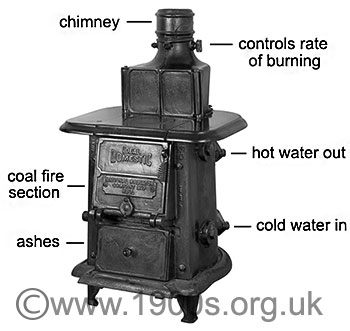
An early domestic coal-fired boiler
At the side or back of the boiler were two pipes connected to a hot tank situated in an airing cupboard. There was no pump in the early boilers, so the airing cupboard needed to be higher than the boiler. Ours, like everyone elses I knew, was upstairs in the bathroom. Hot water, being lighter than cold water, flowed upwards though one pipe and the denser cold water flowed downwards through the other pipe to the boiler. The hot water in the hot water tank fed a tap on the bath and wash basin in the bathroom and one over a sink in the kitchen. The system was kept topped up from a cold water tank in the loft which was maintained automatically from the mains water supply to the house. (In older houses, not connected to the mains, there was a hand pump to get the water from a well.)
In my parents' 1930s house, both the up pipe and the down pipe from the boiler were not hidden inside a wall. They were clearly visible, slanting upwards along the kitchen wall, certainly adding nothing to the kitchen décor. Neither was lagged.
The boiler was on over a low fire all the time so that there was always hot water on tap for washing up and washing hands, etc, but when a bath was required, the boiler was stoked up and more air was allowed in through the controls shown in the picture. Then the up pipe was felt by hand to judge whether the water was hot enough for the bath. When it was, the hot water was run off from the hot tank into the bath in the bathroom and the fire in the boiler was allowed to go out or be doused out low with ash. There was no thermostat as our boiler was an early one, and there was no way that enough water could be heated at any one time for more than one bath. Not that this mattered particularly, because it was quite normal for young children to go in several at a time. Older children went in the same water one after another with the last child in rapidly cooling rather dirty water. Friday night was always bath night and clean clothes were provided for the weekend.
Every kitchen I saw in the 1940s seemed to have such a boiler. Even older properties seemed to have discarded their coppers for these boilers which were still giving good service into the 1950s and later.
The boiler fuel: types of coal
The 'coal' for the boiler had to be a special type which my mother just called 'boiler fuel'. One type, called Phurnicite, looked as if it had been made out of particles, compressed into uniform nuggets. The other type, called Anthracite, looked like small pieces of ordinary coal but it burnt hotter. Both types came in lumps which were small enough to go through the lid of the boiler.
The Phurnicite, Anthracite and regular coal for our coal fires were delivered by a coalman from the local coal yard.
The coal bunker for storing the boiler fuel and regular coal
Our boiler fuel and coal were kept in what was called a coal bunker and was outside the back door.
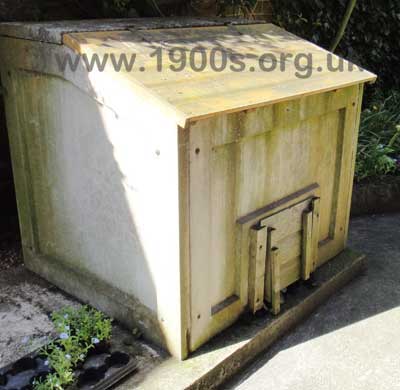
A concrete garden coal bunker
Unlike the one in the picture, our coal bunker was a home-made brick-built container large enough to hold a winter's worth of sack loads with rectangular holes at the bottom for coal shovels to get into. It had a brick partition to keep the boiler fuel separate from the coal for the coal fires, and was covered loosely with corrugated iron which was removed when a delivery was due. It was just under shoulder height, so that the coalman could most easily tip his sack into it.
Loading the boiler and clearing the ash
A domestic boiler was hard work, but it was just accepted as normal by the women of the time. Yes, it was women's work. In the mornings, the ash had to be cleared away with a metal shoven and either put on the garden or wrapped in newspaper and put in the dustbin. Then a new fire had to be laid and lit.
All the versions of the boiler had a lid at the top for the coal to go in. Because the boiler got so hot, the lid was lifted with a detachable handle. It worked like a lever with a kink at one end which fitted into a hollow suitably placed in the lid.
The door in the middle hinged down to create a flat surface showing the red hot coals held in place with a grill. This surface could be used for heating irons for ironing, although we never used it for that purpose as we had an electric iron.
The door at the bottom was for removing the ash and spent cinders.
Boiler models over time
There were a number of models of these boilers. The early 1920s model in the first picture was similar but not identical to the one I grew up with in the 1940s. Whereas the one in that photo is clearly cast iron like the old kitchen ranges, ours was 'stove enamelled' in a mottled pale grey colour like the ones in the photos further down the page. (Stove enamel is a heatproof enamel.)
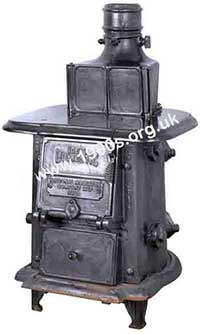
A late 1920s and 1930s coal fired boiler. Photo courtesy of Customer Services, Ideal Heating.
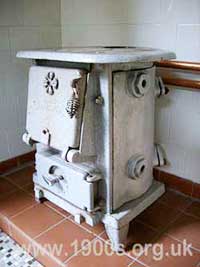
A 1933 boiler, coal fired showing a stove enamel finish. Photo courtesy of Steve James. This boiler is no longer plumbed into a chimney.
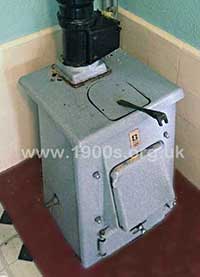
Boiler, stove enamelled, showing the lid with its lever type detached handle. Our boiler was very much like this one, but our lid was round. This photo is courtesy of John Lewis.
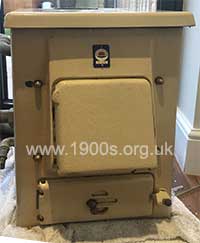
Boiler with a beige stove enamel finish, courtesy Sarah Glock. Obviously it is in the process of suffering the fate of all coal boilers - being uninstalled for something more modern.
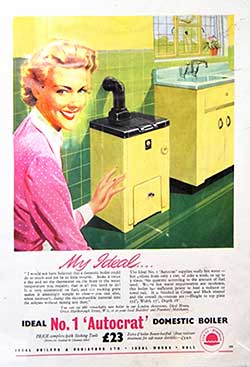
A much more elegant, thermostic version of the boiler water heater from the 1950s.
The image is a full page advert which shows that the boiler cost just £23 - another example of inflation! It also shows a ladylike woman, happy to be in her kitchen - typical of the 1950s approach to women's roles.
The full text of the advert is as follows. The quotes indicate that the words are being spoken by the woman and what follows is the manufacturer's blurb.
"I would not have believed that a domestic boiler could do so much and yet be so little trouble. Stoke it twice a day and set the thermostat on the front to the water temperature you require; that is all you need do! It is very economical on fuel, and the rocking grate makes it amazingly simple to clear—you can also, when necessary, dump the incombustible material into the ashpan without raising any dust."
The Ideal No, 1 'Autocrat' supplies really hot water - 8oo gallons from only 1 cwt of coke a week, or up to 3 times this quantity according the amount of fuel used. Where hot water requirements are moderate, this boiler has sufficient power to heat a radiator or towel rail. It is finished in Cream and Black enamel and the overall dimensions are Height to top plate 25¾", Width 17", Depth 18".
Rooms heated by the boiler
Apart from keeping water hot and heating it, the boiler itself also gave out a great deal of heat. So the kitchen was a warm and cosy living area. We seldom moved out of it in the winters of the early 1940s when my father was away in the army.
The bathroom was also warm for two reasons: It was directly above the warm kitchen and it contained the airing cupboard which housed the hot tank which acted rather like a radiator.
In respect of heating rooms, the coal boiler was different from the other old method of getting instant on-tap hot water, the geyser.
| sources | webmaster | contact |
Text and images are copyright
If you can add anything to this page or provide a photo, please contact me.



